2010 FORD SUPER DUTY heating
[x] Cancel search: heatingPage 18 of 104
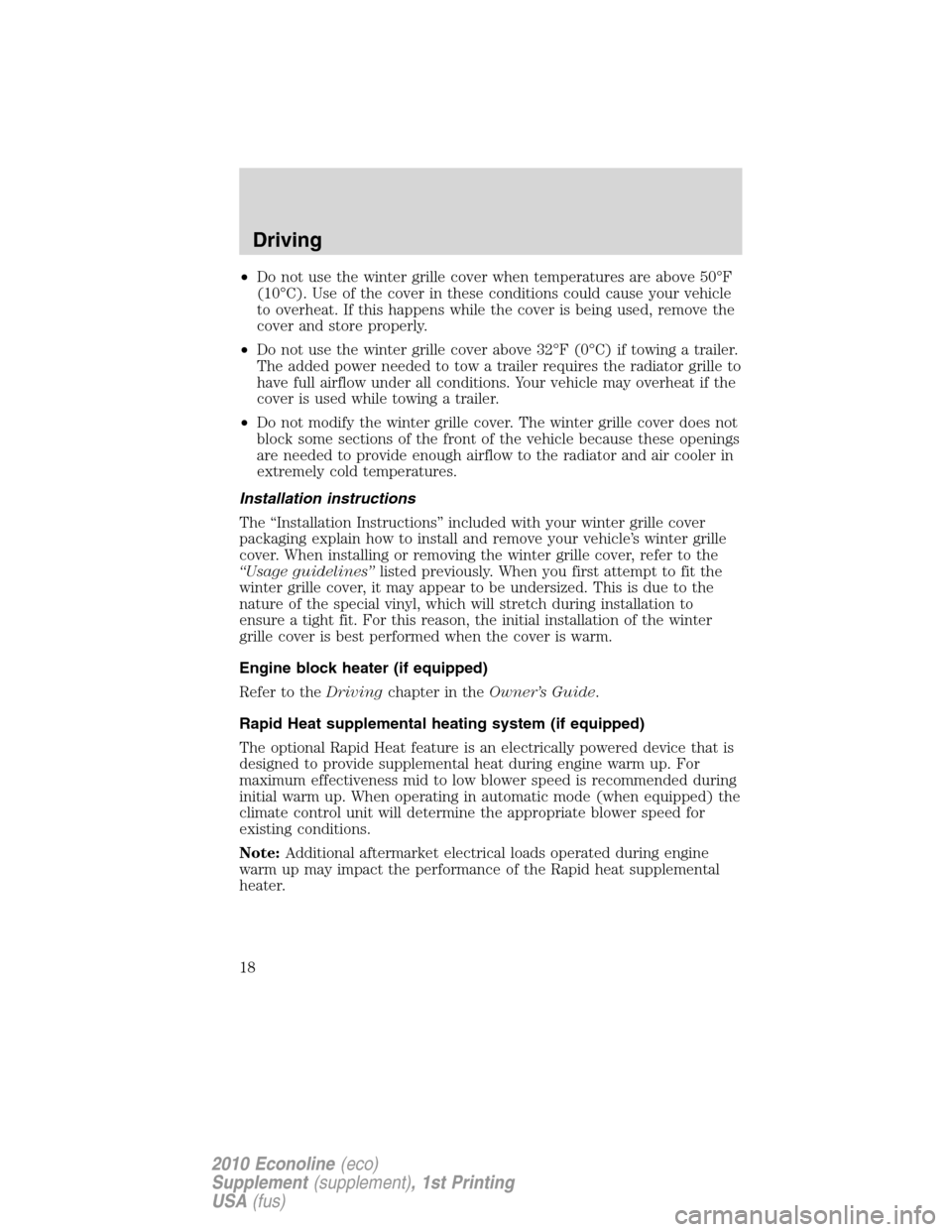
•Do not use the winter grille cover when temperatures are above 50°F
(10°C). Use of the cover in these conditions could cause your vehicle
to overheat. If this happens while the cover is being used, remove the
cover and store properly.
•Do not use the winter grille cover above 32°F (0°C) if towing a trailer.
The added power needed to tow a trailer requires the radiator grille to
have full airflow under all conditions. Your vehicle may overheat if the
cover is used while towing a trailer.
•Do not modify the winter grille cover. The winter grille cover does not
block some sections of the front of the vehicle because these openings
are needed to provide enough airflow to the radiator and air cooler in
extremely cold temperatures.
Installation instructions
The “Installation Instructions” included with your winter grille cover
packaging explain how to install and remove your vehicle’s winter grille
cover. When installing or removing the winter grille cover, refer to the
“Usage guidelines”listed previously. When you first attempt to fit the
winter grille cover, it may appear to be undersized. This is due to the
nature of the special vinyl, which will stretch during installation to
ensure a tight fit. For this reason, the initial installation of the winter
grille cover is best performed when the cover is warm.
Engine block heater (if equipped)
Refer to theDrivingchapter in theOwner’s Guide.
Rapid Heat supplemental heating system (if equipped)
The optional Rapid Heat feature is an electrically powered device that is
designed to provide supplemental heat during engine warm up. For
maximum effectiveness mid to low blower speed is recommended during
initial warm up. When operating in automatic mode (when equipped) the
climate control unit will determine the appropriate blower speed for
existing conditions.
Note:Additional aftermarket electrical loads operated during engine
warm up may impact the performance of the Rapid heat supplemental
heater.
Driving
18
2010 Econoline(eco)
Supplement(supplement), 1st Printing
USA(fus)
Page 37 of 104
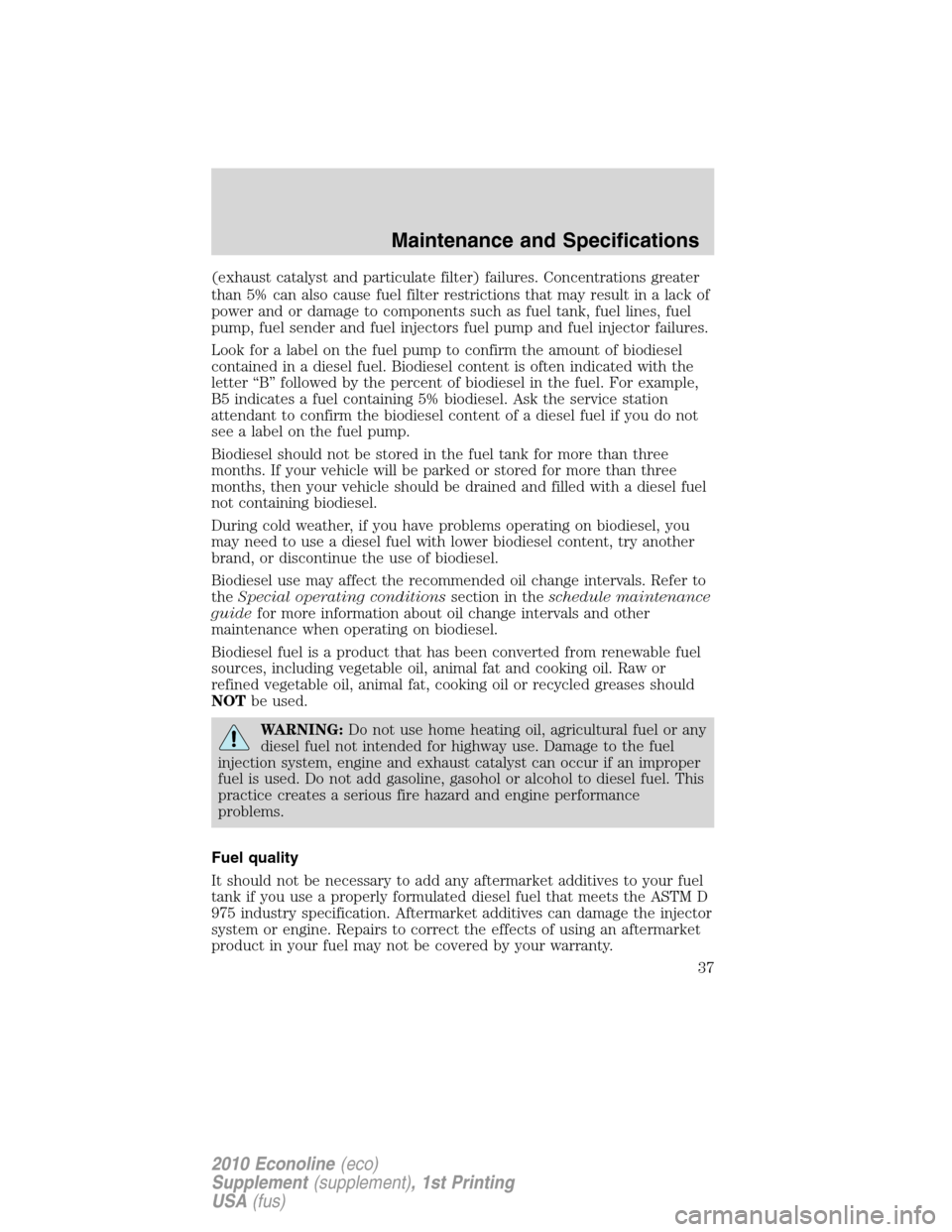
(exhaust catalyst and particulate filter) failures. Concentrations greater
than 5% can also cause fuel filter restrictions that may result in a lack of
power and or damage to components such as fuel tank, fuel lines, fuel
pump, fuel sender and fuel injectors fuel pump and fuel injector failures.
Look for a label on the fuel pump to confirm the amount of biodiesel
contained in a diesel fuel. Biodiesel content is often indicated with the
letter “B” followed by the percent of biodiesel in the fuel. For example,
B5 indicates a fuel containing 5% biodiesel. Ask the service station
attendant to confirm the biodiesel content of a diesel fuel if you do not
see a label on the fuel pump.
Biodiesel should not be stored in the fuel tank for more than three
months. If your vehicle will be parked or stored for more than three
months, then your vehicle should be drained and filled with a diesel fuel
not containing biodiesel.
During cold weather, if you have problems operating on biodiesel, you
may need to use a diesel fuel with lower biodiesel content, try another
brand, or discontinue the use of biodiesel.
Biodiesel use may affect the recommended oil change intervals. Refer to
theSpecial operating conditionssection in theschedule maintenance
guidefor more information about oil change intervals and other
maintenance when operating on biodiesel.
Biodiesel fuel is a product that has been converted from renewable fuel
sources, including vegetable oil, animal fat and cooking oil. Raw or
refined vegetable oil, animal fat, cooking oil or recycled greases should
NOTbe used.
WARNING:Do not use home heating oil, agricultural fuel or any
diesel fuel not intended for highway use. Damage to the fuel
injection system, engine and exhaust catalyst can occur if an improper
fuel is used. Do not add gasoline, gasohol or alcohol to diesel fuel. This
practice creates a serious fire hazard and engine performance
problems.
Fuel quality
It should not be necessary to add any aftermarket additives to your fuel
tank if you use a properly formulated diesel fuel that meets the ASTM D
975 industry specification. Aftermarket additives can damage the injector
system or engine. Repairs to correct the effects of using an aftermarket
product in your fuel may not be covered by your warranty.
Maintenance and Specifications
37
2010 Econoline(eco)
Supplement(supplement), 1st Printing
USA(fus)
Page 77 of 104
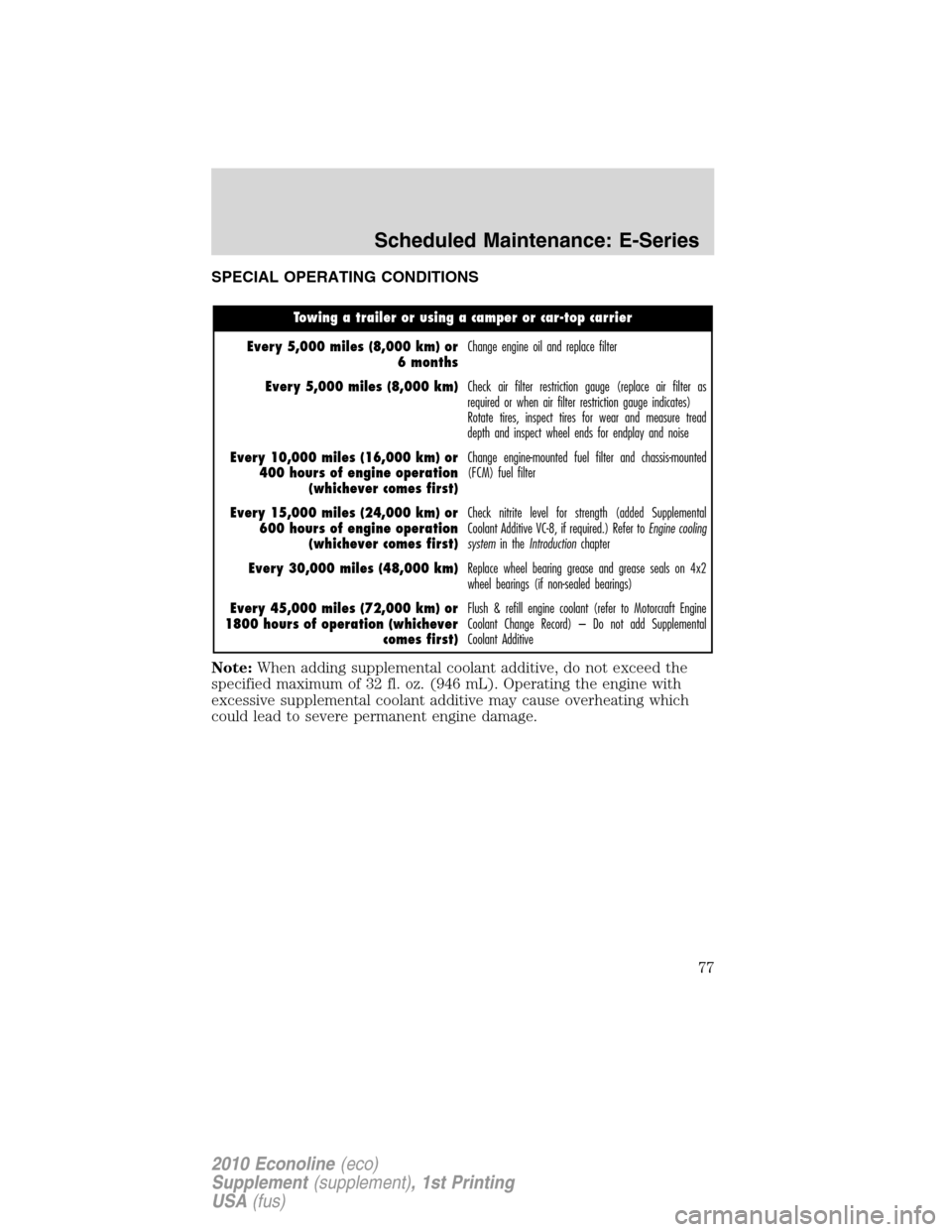
SPECIAL OPERATING CONDITIONS
Towing a trailer or using a camper or car-top carrier
Every 5,000 miles (8,000 km) or
6 monthsChange engine oil and replace filter
Every 5,000 miles (8,000 km)Check air filter restriction gauge (replace air filter as
required or when air filter restriction gauge indicates)
Rotate tires, inspect tires for wear and measure tread
depth and inspect wheel ends for endplay and noise
Every 10,000 miles (16,000 km) or
400 hours of engine operation
(whichever comes first)Change engine-mounted fuel filter and chassis-mounted
(FCM) fuel filter
Every 15,000 miles (24,000 km) or
600 hours of engine operation
(whichever comes first)Check nitrite level for strength (added Supplemental
Coolant Additive VC-8, if required.) Refer to
Engine cooling
systemin theIntroductionchapter
Every 30,000 miles (48,000 km)Replace wheel bearing grease and grease seals on 4x2
wheel bearings (if non-sealed bearings)
Every 45,000 miles (72,000 km) or
1800 hours of operation (whichever
comes first)Flush & refill engine coolant (refer to Motorcraft Engine
Coolant Change Record) – Do not add Supplemental
Coolant Additive
Note:When adding supplemental coolant additive, do not exceed the
specified maximum of 32 fl. oz. (946 mL). Operating the engine with
excessive supplemental coolant additive may cause overheating which
could lead to severe permanent engine damage.
Scheduled Maintenance: E-Series
77
2010 Econoline(eco)
Supplement(supplement), 1st Printing
USA(fus)
Page 78 of 104
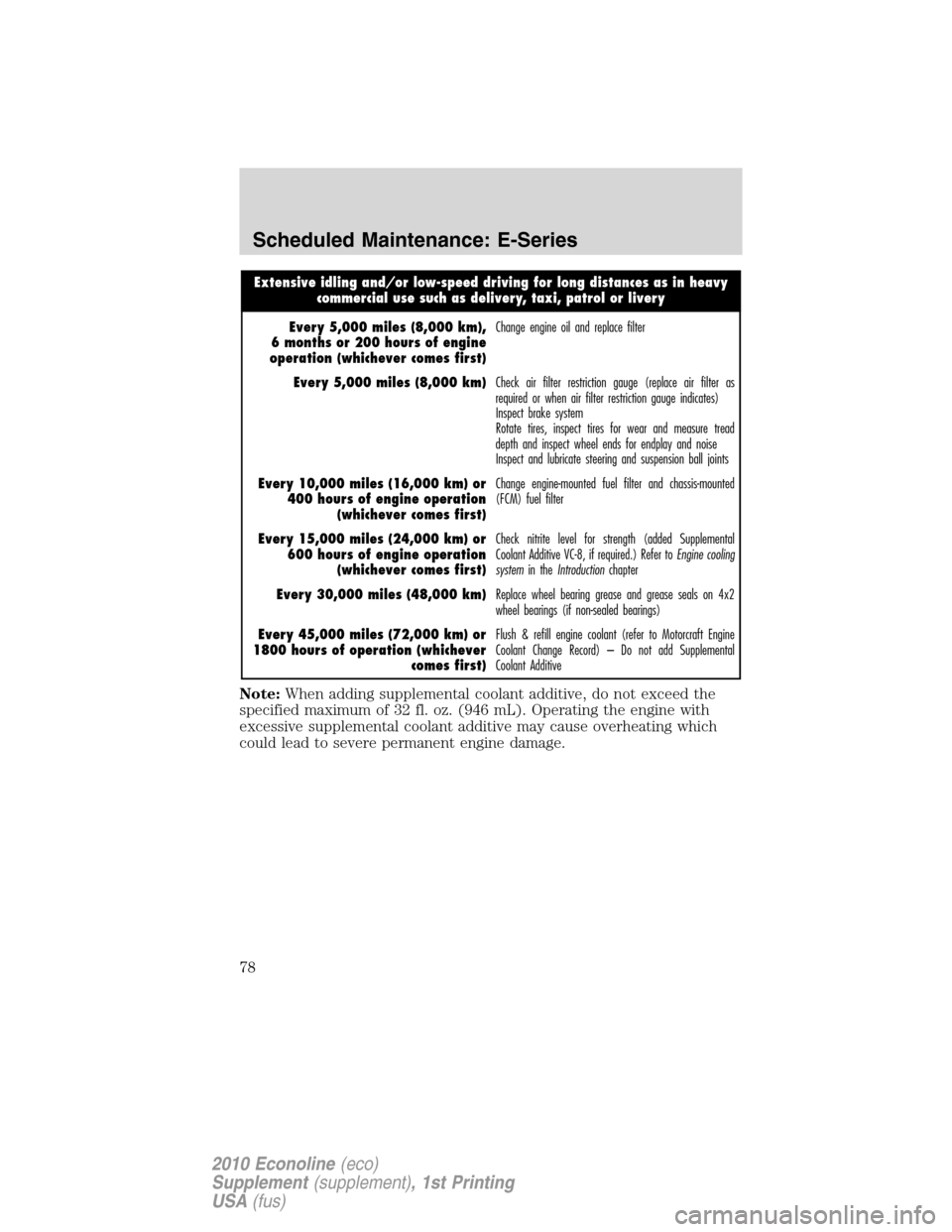
Extensive idling and/or low-speed driving for long distances as in heavy
commercial use such as delivery, taxi, patrol or livery
Every 5,000 miles (8,000 km),
6 months or 200 hours of engine
operation (whichever comes first)Change engine oil and replace filter
Every 5,000 miles (8,000 km)Check air filter restriction gauge (replace air filter as
required or when air filter restriction gauge indicates)
Inspect brake system
Rotate tires, inspect tires for wear and measure tread
depth and inspect wheel ends for endplay and noise
Inspect and lubricate steering and suspension ball joints
Every 10,000 miles (16,000 km) or
400 hours of engine operation
(whichever comes first)Change engine-mounted fuel filter and chassis-mounted
(FCM) fuel filter
Every 15,000 miles (24,000 km) or
600 hours of engine operation
(whichever comes first)Check nitrite level for strength (added Supplemental
Coolant Additive VC-8, if required.) Refer to
Engine cooling
systemin theIntroductionchapter
Every 30,000 miles (48,000 km)Replace wheel bearing grease and grease seals on 4x2
wheel bearings (if non-sealed bearings)
Every 45,000 miles (72,000 km) or
1800 hours of operation (whichever
comes first)Flush & refill engine coolant (refer to Motorcraft Engine
Coolant Change Record) – Do not add Supplemental
Coolant Additive
Note:When adding supplemental coolant additive, do not exceed the
specified maximum of 32 fl. oz. (946 mL). Operating the engine with
excessive supplemental coolant additive may cause overheating which
could lead to severe permanent engine damage.
Scheduled Maintenance: E-Series
78
2010 Econoline(eco)
Supplement(supplement), 1st Printing
USA(fus)
Page 79 of 104
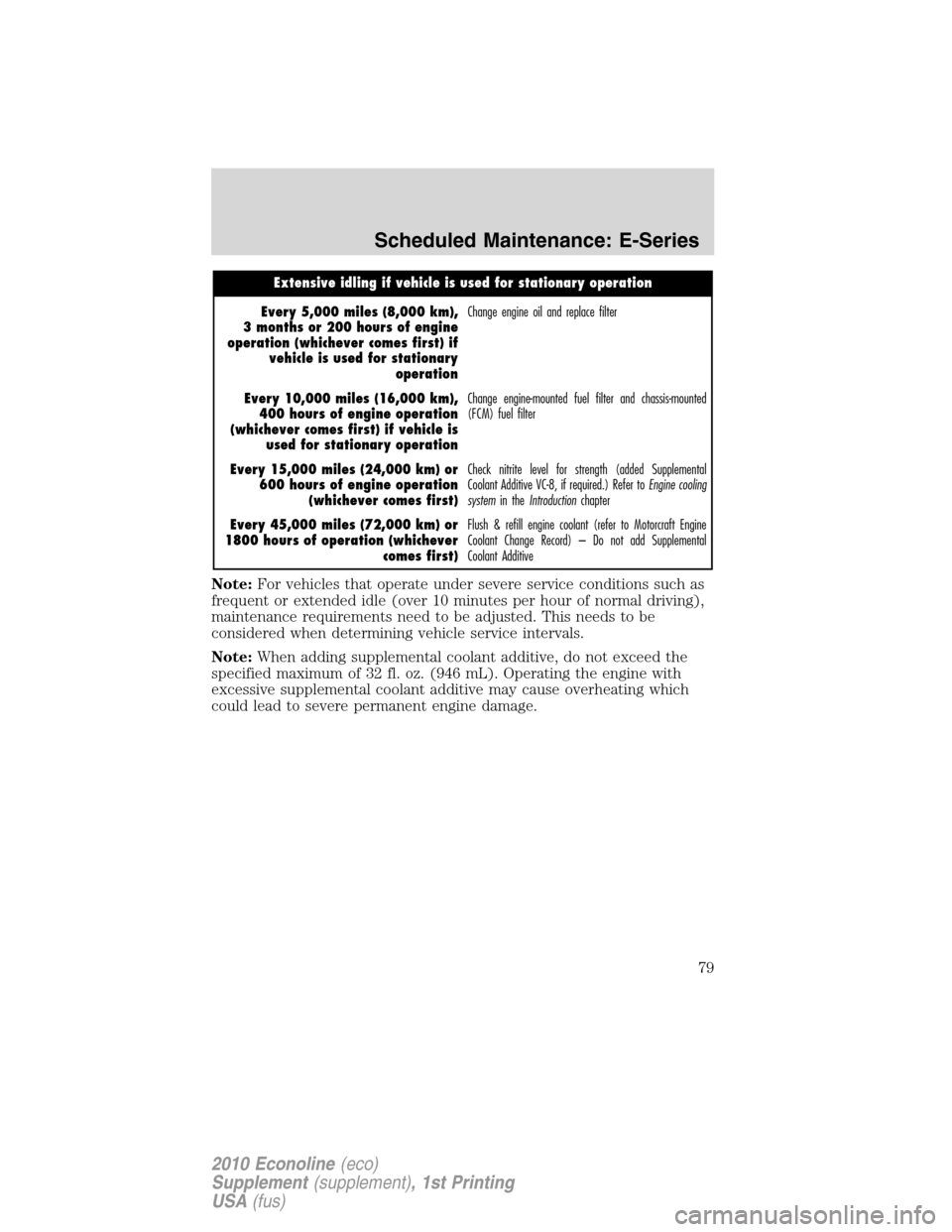
Extensive idling if vehicle is used for stationary operation
Every 5,000 miles (8,000 km),
3 months or 200 hours of engine
operation (whichever comes first) if
vehicle is used for stationary
operationChange engine oil and replace filter
Every 10,000 miles (16,000 km),
400 hours of engine operation
(whichever comes first) if vehicle is
used for stationary operationChange engine-mounted fuel filter and chassis-mounted
(FCM) fuel filter
Every 15,000 miles (24,000 km) or
600 hours of engine operation
(whichever comes first)Check nitrite level for strength (added Supplemental
Coolant Additive VC-8, if required.) Refer to
Engine cooling
systemin theIntroductionchapter
Every 45,000 miles (72,000 km) or
1800 hours of operation (whichever
comes first)Flush & refill engine coolant (refer to Motorcraft Engine
Coolant Change Record) – Do not add Supplemental
Coolant Additive
Note:For vehicles that operate under severe service conditions such as
frequent or extended idle (over 10 minutes per hour of normal driving),
maintenance requirements need to be adjusted. This needs to be
considered when determining vehicle service intervals.
Note:When adding supplemental coolant additive, do not exceed the
specified maximum of 32 fl. oz. (946 mL). Operating the engine with
excessive supplemental coolant additive may cause overheating which
could lead to severe permanent engine damage.
Scheduled Maintenance: E-Series
79
2010 Econoline(eco)
Supplement(supplement), 1st Printing
USA(fus)
Page 91 of 104
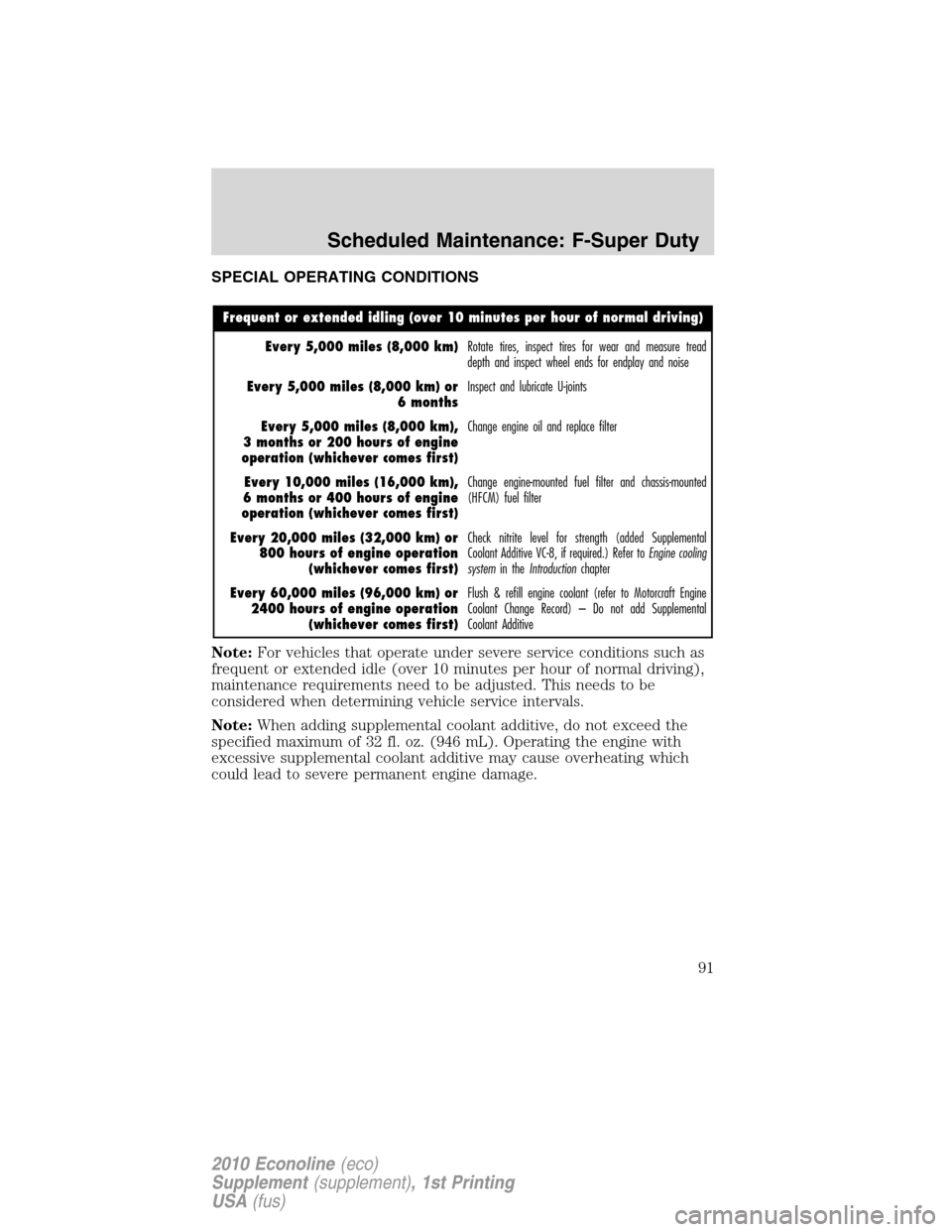
SPECIAL OPERATING CONDITIONS
Frequent or extended idling (over 10 minutes per hour of normal driving)
Every 5,000 miles (8,000 km)Rotate tires, inspect tires for wear and measure tread
depth and inspect wheel ends for endplay and noise
Every 5,000 miles (8,000 km) or
6 monthsInspect and lubricate U-joints
Every 5,000 miles (8,000 km),
3 months or 200 hours of engine
operation (whichever comes first)Change engine oil and replace filter
Every 10,000 miles (16,000 km),
6 months or 400 hours of engine
operation (whichever comes first)Change engine-mounted fuel filter and chassis-mounted
(HFCM) fuel filter
Every 20,000 miles (32,000 km) or
800 hours of engine operation
(whichever comes first)Check nitrite level for strength (added Supplemental
Coolant Additive VC-8, if required.) Refer to
Engine cooling
systemin theIntroductionchapter
Every 60,000 miles (96,000 km) or
2400 hours of engine operation
(whichever comes first)Flush & refill engine coolant (refer to Motorcraft Engine
Coolant Change Record) – Do not add Supplemental
Coolant Additive
Note:For vehicles that operate under severe service conditions such as
frequent or extended idle (over 10 minutes per hour of normal driving),
maintenance requirements need to be adjusted. This needs to be
considered when determining vehicle service intervals.
Note:When adding supplemental coolant additive, do not exceed the
specified maximum of 32 fl. oz. (946 mL). Operating the engine with
excessive supplemental coolant additive may cause overheating which
could lead to severe permanent engine damage.
Scheduled Maintenance: F-Super Duty
91
2010 Econoline(eco)
Supplement(supplement), 1st Printing
USA(fus)
Page 93 of 104
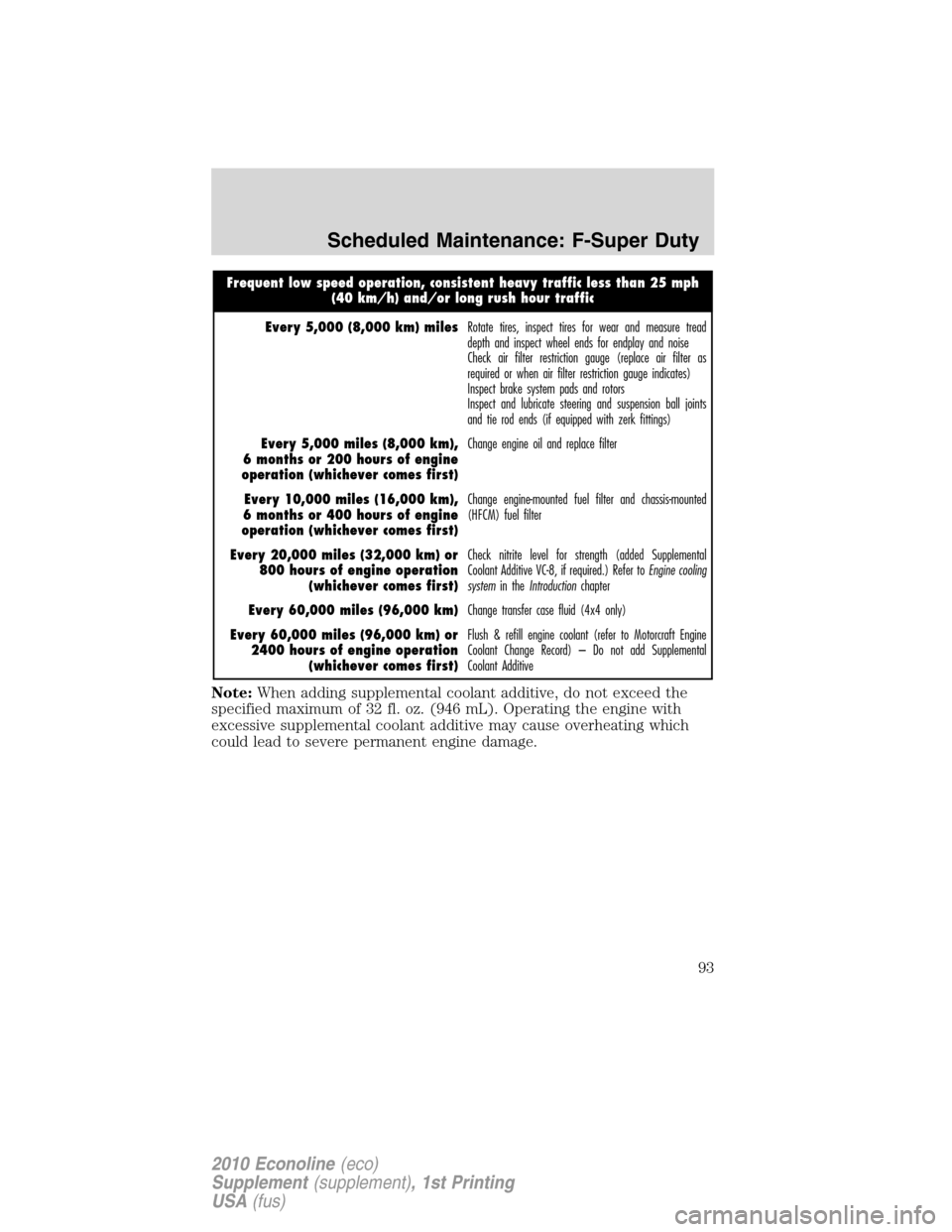
Frequent low speed operation, consistent heavy traffic less than 25 mph
(40 km/h) and/or long rush hour traffic
Every 5,000 (8,000 km) milesRotate tires, inspect tires for wear and measure tread
depth and inspect wheel ends for endplay and noise
Check air filter restriction gauge (replace air filter as
required or when air filter restriction gauge indicates)
Inspect brake system pads and rotors
Inspect and lubricate steering and suspension ball joints
and tie rod ends (if equipped with zerk fittings)
Every 5,000 miles (8,000 km),
6 months or 200 hours of engine
operation (whichever comes first)Change engine oil and replace filter
Every 10,000 miles (16,000 km),
6 months or 400 hours of engine
operation (whichever comes first)Change engine-mounted fuel filter and chassis-mounted
(HFCM) fuel filter
Every 20,000 miles (32,000 km) or
800 hours of engine operation
(whichever comes first)Check nitrite level for strength (added Supplemental
Coolant Additive VC-8, if required.) Refer to
Engine cooling
systemin theIntroductionchapter
Every 60,000 miles (96,000 km)Change transfer case fluid (4x4 only)
Every 60,000 miles (96,000 km) or
2400 hours of engine operation
(whichever comes first)Flush & refill engine coolant (refer to Motorcraft Engine
Coolant Change Record) – Do not add Supplemental
Coolant Additive
Note:When adding supplemental coolant additive, do not exceed the
specified maximum of 32 fl. oz. (946 mL). Operating the engine with
excessive supplemental coolant additive may cause overheating which
could lead to severe permanent engine damage.
Scheduled Maintenance: F-Super Duty
93
2010 Econoline(eco)
Supplement(supplement), 1st Printing
USA(fus)
Page 94 of 104
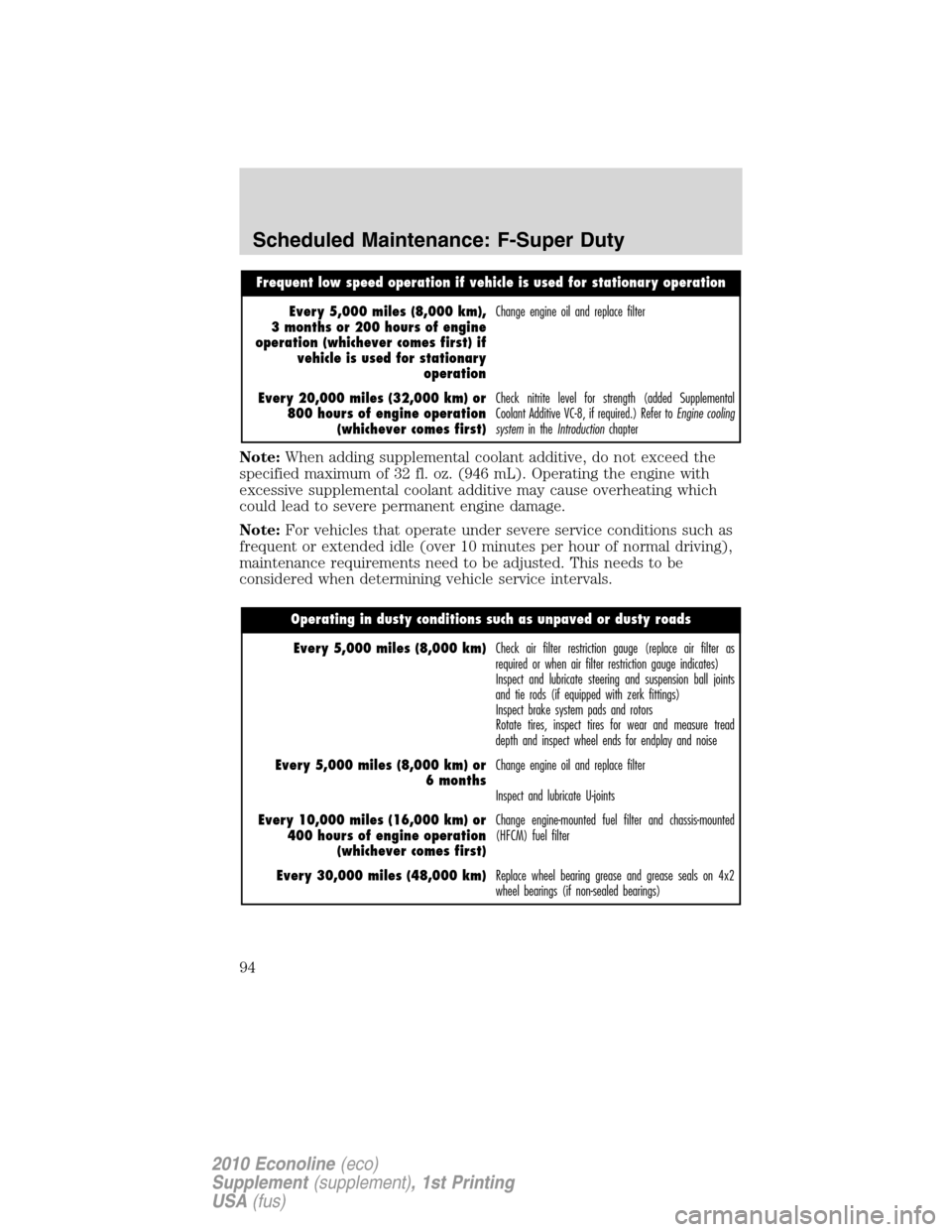
Frequent low speed operation if vehicle is used for stationary operation
Every 5,000 miles (8,000 km),
3 months or 200 hours of engine
operation (whichever comes first) if
vehicle is used for stationary
operationChange engine oil and replace filter
Every 20,000 miles (32,000 km) or
800 hours of engine operation
(whichever comes first)Check nitrite level for strength (added Supplemental
Coolant Additive VC-8, if required.) Refer to
Engine cooling
systemin theIntroductionchapter
Note:When adding supplemental coolant additive, do not exceed the
specified maximum of 32 fl. oz. (946 mL). Operating the engine with
excessive supplemental coolant additive may cause overheating which
could lead to severe permanent engine damage.
Note:For vehicles that operate under severe service conditions such as
frequent or extended idle (over 10 minutes per hour of normal driving),
maintenance requirements need to be adjusted. This needs to be
considered when determining vehicle service intervals.
Operating in dusty conditions such as unpaved or dusty roads
Every 5,000 miles (8,000 km)Check air filter restriction gauge (replace air filter as
required or when air filter restriction gauge indicates)
Inspect and lubricate steering and suspension ball joints
and tie rods (if equipped with zerk fittings)
Inspect brake system pads and rotors
Rotate tires, inspect tires for wear and measure tread
depth and inspect wheel ends for endplay and noise
Every 5,000 miles (8,000 km) or
6 monthsChange engine oil and replace filter
Inspect and lubricate U-joints
Every 10,000 miles (16,000 km) or
400 hours of engine operation
(whichever comes first)Change engine-mounted fuel filter and chassis-mounted
(HFCM) fuel filter
Every 30,000 miles (48,000 km)Replace wheel bearing grease and grease seals on 4x2
wheel bearings (if non-sealed bearings)
Scheduled Maintenance: F-Super Duty
94
2010 Econoline(eco)
Supplement(supplement), 1st Printing
USA(fus)